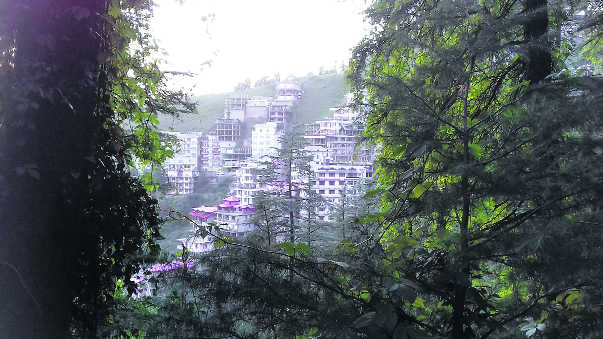
A view of ‘village’ Dudhli.
Shriniwas Joshi
There are many villages in Himachal Pradesh that have lost their old sheen and culture. The villages that are touched by the metalled roads undergo metamorphosis to look like petty towns, but carry with them the nomenclature of village. That day is not far when Lahaul and Spiti, which has saved its culture so far because of the difficult Rohtang Pass, will shake off its originality, as the tunnel through Rohtang opens up for traffic.
One such village is Dudhli, in Bhont Panchayat, hardly 2 km away from the last locality of Shimla town on its northern side. I have seen it mounting from a couple of slate-roofed houses with fields growing corn, potato, pumpkins, cucumbers, wheat and what not to a mosaic of huge structures. The slate-roofed houses which were predominant in the villages here are visible in poems only. Late Tej Ram Sharma, a poet of repute says, ”Mainen der raat/ pahaar ki slate chat par dekhe hain/ chaandni ke naachte sapne” (I have seen, on late nights, the dreams of moonlight dancing on slate-roofs in the hills.) These dreams are mere dreams now. There are roof gardens at Dudhli on the umpteenth story of a building. The high-rising brick and mortar structures have occupied the fields, which were once growing vegetables and other crops. The identity of original villagers, now, stands merged with those who have built the houses here. Dudhli, today, has a public school, a gym, a car service centre, clinics, home stays, shops selling from potatoes to paints and ply-wood. But when I ask somebody who his neighbor is, his reply generally is downbeat. That old camaraderie is missing. Is it development?
There are two versions of why the place is called Dudhli. One of that is that milk (dudh or doodh) from here used to go to the Shimla town and was sold there because the villagers used to rear buffalos and cows. The times have changed and milk in sachets comes from the town to Dudhli village now. Is it development? The other, according to the late, Dr Vidya Chand Thakur, an etymologist, is that a creeper that twines round trees called Cryptolepsis buchanani or wax-leaved climber or Indian sarsaparilla was grown here in abundance. It is called ‘kala bel’ or ‘karanta’ in Hindi. It is useful in loss of appetite, fever and skin diseases and is considered as blood purifier. The herb may, however, be used only after consulting a physician. The herb and its curative properties are forgotten now. Is it development?
Earlier every village of Himachal Pradesh was planned strictly in consonance with contours and levels of topography. Efforts were made to orient the plans in such a way that buildings stay sun-friendly and the natural scenery is not disturbed. Knowingly or not knowingly, a small slate-roofed house with ‘obra’ or cow-shelter in the ground floor was constructed so that it cared for the view, vision and vista. Not now, excessive use of RCC has already damaged the eco-system of the villages here. But the villages, by virtue of having high-rise buildings, have not converted themselves into towns. These are the panchayats that look after the villages and these have failed in keeping the villages clean despite grabbing ‘nirmal gramin puruskar’ from the government. The result is that the forests nearby the ‘brick and mortar villages’ have become the dumping grounds of the generated garbage. It is not that the panchayats can do nothing in the wayward construction taking place in the villages but panchayats tend to ignore the provisions given under Section 13 of the HP Panchayati Raj Act: “to regulate the construction of new buildings or the extension or alterations of any existing building or the abadi”.
I am quoting Peter Popham, “The British came to Simla as a way to detach themselves from India while continuing to rule it, and as a way of restoring themselves in the mild weather among their own kind. What they wanted was a sort of seasonal apartheid. A Simla-lover, if bitten by the ‘Jewel in the Crown’ bug, arrives in Shimla today, he will find the toy train chugged up the mountains by diesel instead of steam. He may have a nasty shock on arriving here. The pretty little deodar-shaded place is a boom town of 1.70 lakh persons with an equal number of floating populations. Seen from Taradevi, it depicts a house over house that have eaten the mountain flanks. Get closer and it’s an ugly riot of concrete hotels and shops and restaurants, slammed together with as little thought for nostalgic sensibilities as for fire codes. The bazaar has taken over all open spaces. At this point the crestfallen colonial may feel like skulking back to the toy train and rolling down the hill to Delhi.”
What is true of Shimla is also true of the villages on which the shadow of the towns falls.
Tailpiece
The Magnet Theory of towns and villages say that the towns are magnets and villages are iron filings.



























